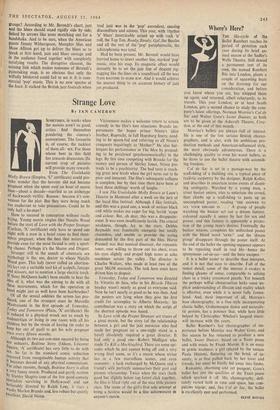Where's Here?
THE life-cycle of the Ballet Rambert reaches its period of gestation each year during its brief an- nual season at the Sadler's Wells.Theatre. Still denied a permanent tent of its own, the nomad Rambert flits into London, plants a couple of squawling brats on the' doorstep for our consideration, and before
you know where you are, has whipped them up again, and returned, albeit reluctantly, to its travels. This year London, or at least South London, gets a second chance to study the com- pany's latest offerings, Norman Morrice's Cul de Sac and Walter Gore's Sweet Dancer, as both are to be given at the Ashcroft Theatre, Croy- don, at the end of this month.
Morrice's ballets are always full of interest. He is one of the few serious British choreo- graphers, and is also, with his ambitious pro- duction methods and 'American-influenced style, the most obviously adventurous. There is a challenging quality to even his worst ballets, as he dares to use the ballet theatre with astonish- ing freedom.
Cul de Sac is set in a passage-way by the scaffolding of a building site, a typical piece of realistic carpentry by the designer, Ralph Koltai, and describes in uncertain terms events of daunt- ing ambiguity. Watched by a young man, a street busker enters, tries to entertain the crowd, then climbs up a scaffolding to paste up an uncompleted poster, reading 'THE ANSWER TO ALL YOUR DREAMS IS . . .' A group of people watching the busker act out a dream fantasy, coloured equally it seems by lust for sex and power, and this fantasy is apparently a projec- tion of the young man's desires. Eventually the busker returns, completes his unfinished poster with the bland word 'HERE!' and the 'dream group' disappears through the poster itself. At the end of the ballet the opening sequence appears to be repeating itself in real life—hence the eponymous cul-de-sac—and the hero escapes.
It is a ballet easier to describe than interpret, and it is not that easy to describe. Full of the tiniest detail, some of the interest it evokes is finding gleams of sense, comparable to solving clues in a tricky 'crossword puzzle. Yet beneath the perhaps wilful obscurantism lurks some im- plicit understanding of illusion and reality which is effective, even while it is never fully formu- lated. And, most important of all, Morrice's lean choreography, in a free style incorporating classic ballet, Grahamesque dance and naturalis- tic gesture, has a potency that, while here little helped by Christopher Whelan's languid music, will increase with the years.
Ballet Rambert's last choreographer of im- portance before Morrice was Walter Gore, and this season he has returned to produce a new ballet, .Sweet Dancer, based on a Yeats poem and with music by Frank Martin. It is an essay in gentle madness; a girl (played by the unique Paula Hinton), fluttering on the brink of in- sanity, is at first pulled back by her lover and friends, but must be finally led away into limbo.
Romantic, charming and yet pungent, Gore's ballet has just the qualities of the Yeats poem which sparked it off. His choreography, .deli- cately varied both in time and space, has com- pulsive vigour, and, like Cul de Sac, the ballet is excellently cast and performed.
CLI VE BARNES


































 Previous page
Previous page